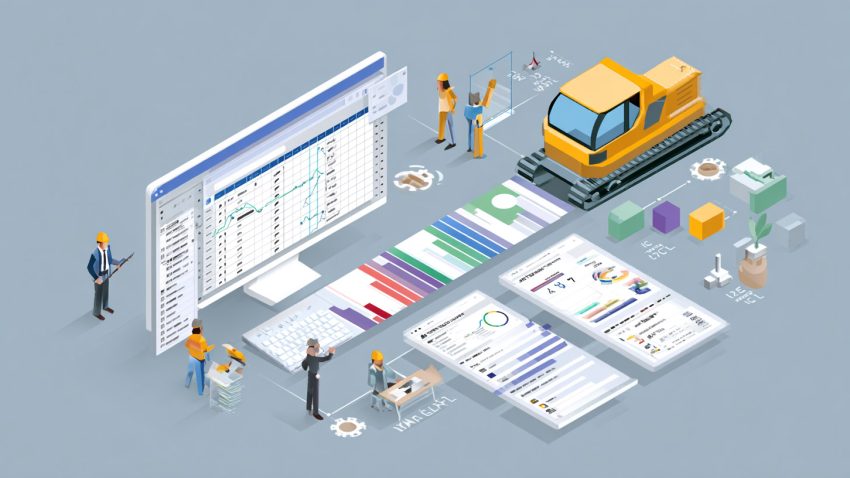Superintendents: Effective Training Strategies for Construction Management Software Users
Table of Contents:

Explore effective training strategies for construction management software users. Understand how tailored training modules, hands-on workshops, and user-friendly resources can enhance software proficiency and improve project outcomes.
In the construction industry, the successful implementation of management software can significantly enhance project efficiency, streamline workflows, and improve overall outcomes. However, the true potential of these tools can only be realized if users are proficient in their use. Building competency through effective training strategies is essential for ensuring that construction professionals can fully leverage the capabilities of their software.
This guide delves into the most effective training strategies for construction management software users. From tailored training modules to hands-on workshops and user-friendly resources, we’ll explore how these methods can enhance software proficiency and ultimately lead to better project results.
The Importance of Effective Training in Construction Management Software
Enhancing Software Proficiency
Tailored Training Modules
Tailored training modules are designed to meet the specific needs and skill levels of different users. By customizing training to address the unique requirements of various roles within the construction team, users can gain a deeper understanding of the software features that are most relevant to their tasks.
For example, a project manager may need training focused on scheduling and resource allocation, while a field engineer might benefit more from modules on mobile access and real-time updates. Tailoring training in this way ensures that each user receives the most pertinent information, enhancing their proficiency and confidence.
Improving Project Outcomes
Hands-On Workshops
Hands-on workshops provide an interactive learning environment where users can practice using the software in real-world scenarios. These workshops allow participants to apply what they’ve learned in a controlled setting, gaining practical experience that translates directly to their daily tasks.
For instance, a workshop might simulate a project setup, including task assignment, progress tracking, and issue resolution. By working through these scenarios, users can see firsthand how the software can streamline their workflows and improve project outcomes.
Ensuring User Engagement
User-Friendly Resources
User-friendly resources such as tutorials, guides, and FAQs are essential for supporting ongoing learning and troubleshooting. These resources should be easily accessible and designed to help users quickly find the information they need.
For example, a comprehensive online help center that includes video tutorials, step-by-step guides, and searchable FAQs can empower users to solve problems independently and continue learning at their own pace. This accessibility fosters a culture of continuous improvement and self-sufficiency.
Key Training Strategies for Construction Management Software
Developing Comprehensive Training Programs
Structured Learning Paths
Developing comprehensive training programs with structured learning paths ensures that all users receive a well-rounded education on the software. These programs should cover basic functionalities as well as advanced features, providing a solid foundation for all users.
For example, a training program might start with introductory modules on navigation and basic tasks, followed by intermediate sessions on project management features, and advanced workshops on custom reporting and analytics. This structured approach ensures that users build their knowledge progressively.
Encouraging Active Participation
Interactive Training Sessions
Interactive training sessions, such as live webinars and Q&A sessions, encourage active participation and engagement. These sessions allow users to ask questions, receive real-time feedback, and engage with instructors and peers.
For instance, a live webinar might include demonstrations of key features followed by a Q&A segment where participants can clarify doubts and discuss specific use cases. This interactive format helps reinforce learning and ensures that users feel supported throughout their training journey.
Providing Continuous Learning Opportunities
Ongoing Education Programs
Continuous learning opportunities such as refresher courses, advanced training modules, and certifications help users stay up-to-date with software updates and new features. These programs ensure that users continue to grow their skills and adapt to evolving industry practices.
For example, StruxHub might offer quarterly refresher courses that cover recent software updates and enhancements. Advanced training modules could delve into specialized areas like data analytics or mobile integration, providing users with deeper insights and new capabilities.
Real-World Applications of Effective Training Strategies

StruxHub
Experience the power of StruxHub today and witness firsthand how it can revolutionize your construction operations.
Enhancing Efficiency with Tailored Training
By implementing tailored training modules, construction companies have seen significant improvements in software proficiency and project efficiency. Customizing training to the specific needs of different roles ensures that each user can fully utilize the software features that are most relevant to their tasks.
Improving Project Outcomes with Hands-On Workshops
Hands-on workshops have proven to be highly effective in translating theoretical knowledge into practical skills. By simulating real-world scenarios, these workshops help users understand how to apply the software to their daily tasks, resulting in smoother workflows and better project outcomes.
Ensuring User Engagement with User-Friendly Resources
Providing user-friendly resources has been key to maintaining high levels of user engagement and satisfaction. Comprehensive online help centers, video tutorials, and searchable FAQs empower users to find answers independently and continue learning at their own pace.
Related Posts:
The Ultimate Guide to Construction Management Software for Superintendents
How to Choose the Top Construction Scheduling Software for Field Teams
Top 12 Tips for Effective Training in Construction Management Software

StruxHub: Revolutionizing Project Management in Large Commercial Construction
1. Develop Structured Learning Paths
Create comprehensive training programs with structured learning paths to ensure a well-rounded education for all users.
2. Tailor Training Modules
Customize training to address the specific needs and skill levels of different users, ensuring relevance and effectiveness.
3. Offer Hands-On Workshops
Provide hands-on workshops that simulate real-world scenarios, allowing users to apply their knowledge in practical settings.
4. Use Interactive Training Sessions
Encourage active participation and engagement with interactive training sessions such as live webinars and Q&A sessions.
5. Provide User-Friendly Resources
Ensure that users have access to tutorials, guides, and FAQs that are easily accessible and designed to support ongoing learning.
6. Implement Ongoing Education Programs
Offer continuous learning opportunities such as refresher courses, advanced training modules, and certifications to keep users updated.
7. Encourage Peer Learning
Promote a culture of peer learning where users can share knowledge and learn from each other’s experiences.
8. Track Training Progress
Monitor training progress and completion rates to ensure that all users are adequately trained.
9. Gather Feedback
Collect feedback from users to identify areas for improvement and enhance the training program.
10. Recognize Achievements
Acknowledge and reward users who complete training programs and demonstrate proficiency in using the software.
11. Stay Updated with Software Enhancements
Ensure that training programs are regularly updated to reflect new features and enhancements in the software.
12. Foster a Culture of Continuous Improvement
Encourage a mindset of continuous improvement within the organization by emphasizing the importance of ongoing training and development.
Building Competency with Effective Training Strategies

Effective training strategies are crucial for building competency in construction management software. By implementing tailored training modules, hands-on workshops, and user-friendly resources, construction companies can enhance software proficiency, improve project outcomes, and ensure ongoing user engagement. Embrace these strategies to empower your team and drive project success.
StruxHub enhances efficiency and coordination across all project phases, providing a single source of truth that eliminates silos and fosters collaboration. Real-time updates, financial management tools, and seamless commvunication features ensure that all team members and stakeholders are aligned and informed, reducing the risk of errors and delays. With comprehensive solutions for document management, risk mitigation, and quality control, StruxHub maintains project integrity and safety, while mobile access and integration capabilities further enhance project flexibility and efficiency.
StruxHub’s Key Features and Benefits:
- Advanced Delivery Management: Automate and optimize your delivery schedules, ensuring materials arrive just in time, every time.
- Site Communication: Utilize georeferenced maps and instant messaging to keep every team member informed and aligned.
- Construction Materials Management: Track inventory levels and manage materials procurement with ease, reducing waste and avoiding project delays.
- Construction Safety & Inspection Workflows: Implement customizable mobile forms for conducting safety inspections and managing compliance documentation effortlessly.
- Short-Term Scheduling: Visualize project tasks with detailed floor plans, linking each activity to specific locations for better planning accuracy.
- Construction Resource Management: Efficiently allocate personnel and equipment, maximizing productivity and reducing idle time.
StruxHub’s Product Offering:
- StruxHub Deliveries: Simplifies the coordination of incoming deliveries, ensuring materials and equipment are precisely timed to project needs.
- StruxHub Logistics: Offers intelligent site logistics planning, from crane scheduling to space allocation, for smoother operations.
- StruxHub Safety: Elevates on-site safety standards with easy-to-use tools for inspections, permits, and incident reporting.
- StruxHub Scheduling: Enhances project timelines with intuitive scheduling tools that ensure tasks are completed efficiently and on time.
With StruxHub, construction companies can look forward to a streamlined, more efficient project execution that delivers on time and within budget. Embrace the power of innovation and take your construction projects to the next level.
Don’t miss out on the opportunity to optimize your construction management processes with StruxHub. Sign up for a free demo today. Let’s build smarter, together.
FAQ

1. How can tailored training modules enhance software proficiency?
Tailored training modules enhance software proficiency by addressing the specific needs and skill levels of different users. Customizing training ensures that each user receives the most relevant information, enabling them to fully utilize the software features that are most pertinent to their tasks.
For example, a project manager might need training focused on scheduling and resource allocation, while a field engineer might benefit more from modules on mobile access and real-time updates. Tailoring training in this way ensures that each user gains a deeper understanding of the software and can apply it effectively in their role.
2. What are the benefits of hands-on workshops in construction management software training?
Hands-on workshops provide an interactive learning environment where users can practice using the software in real-world scenarios. These workshops allow participants to apply what they’ve learned in a controlled setting, gaining practical experience that translates directly to their daily tasks.
For instance, a workshop might simulate a project setup, including task assignment, progress tracking, and issue resolution. By working through these scenarios, users can see firsthand how the software can streamline their workflows and improve project outcomes. This practical experience builds confidence and competence in using the software.
3. How do user-friendly resources support ongoing learning and troubleshooting?
User-friendly resources such as tutorials, guides, and FAQs are essential for supporting ongoing learning and troubleshooting. These resources should be easily accessible and designed to help users quickly find the information they need.
For example, a comprehensive online help center that includes video tutorials, step-by-step guides, and searchable FAQs can empower users to solve problems independently and continue learning at their own pace. This accessibility fosters a culture of continuous improvement and self-sufficiency, ensuring that users can effectively use the software and resolve any issues that arise.
4. What tips should construction teams follow to maximize the effectiveness of training programs?
To maximize the effectiveness of training programs, construction teams should follow these tips:
- Develop Structured Learning Paths: Create comprehensive training programs with structured learning paths to ensure a well-rounded education for all users.
- Tailor Training Modules: Customize training to address the specific needs and skill levels of different users, ensuring relevance and effectiveness.
- Offer Hands-On Workshops: Provide hands-on workshops that simulate real-world scenarios, allowing users to apply their knowledge in practical settings.
- Use Interactive Training Sessions: Encourage active participation and engagement with interactive training sessions such as live webinars and Q&A sessions.
- Provide User-Friendly Resources: Ensure that users have access to tutorials, guides, and FAQs that are easily accessible and designed to support ongoing learning.
- Implement Ongoing Education Programs: Offer continuous learning opportunities such as refresher courses, advanced training modules, and certifications to keep users updated.
- Encourage Peer Learning: Promote a culture of peer learning where users can share knowledge and learn from each other’s experiences.
- Track Training Progress: Monitor training progress and completion rates to ensure that all users are adequately trained.
- Gather Feedback: Collect feedback from users to identify areas for improvement and enhance the training program.
- Recognize Achievements: Acknowledge and reward users who complete training programs and demonstrate proficiency in using the software.
- Stay Updated with Software Enhancements: Ensure that training programs are regularly updated to reflect new features and enhancements in the software.
- Foster a Culture of Continuous Improvement: Encourage a mindset of continuous improvement within the organization by emphasizing the importance of ongoing training and development.



